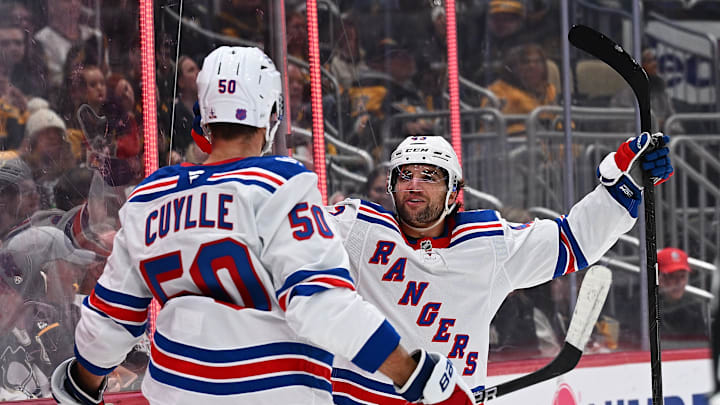You can't script it anymore, ironically. Through six games, the Blueshirts are doing everything right — outshooting, outchancing, and outskating playoff teams at five-on-five — yet they're sitting at 2-3-1.
If you said September, that this team would hold nearly 69% of the expected goals across matchups with Washington, Edmonton, and Toronto, you'd assumed they were 5-1. Mike Sullivan was already being penciled in for the Jack Adams. Instead, they're leaving every rink shaking their heads. Now, let's not get carried away because it's only game six, but even this small sample size is puzzling.
Take Thursday night in Toronto. The Rangers controlled zone time, puck possession, and even high-danger looks to the tune of 13-4. The two goals they surrendered weren't on Igor Shesterkin. One was a fluky bounce off Matthew Knies in front, the other a backdoor tap-in — William Nylander to Auston Matthews in overtime. There's not a goalie alive who's stopping that. Shesty's been rock solid, the world-class goaltender he's known to be. He's been brilliant — top of the league in Goals Saved Above Expected (+5.26) — but he can't score them, either.
Igor Shesterkin...
— Mike Kelly (@MikeKellyNHL) October 17, 2025
2 wins in his first 5 games.
All 5 starts have been quality starts (+ goals saved above expected).
3 of the top 15 goalie performances this season (by GSAE).
Leads NHL in save % (min. 2 games), despite facing league-high 63 slot shots.
Leads NHL with 7.5 GSAE. pic.twitter.com/QwvksTS5fJ
The numbers are great on paper, but the game is played on ice
At five-on-five, the Rangers rank first in high-danger chances against per 60 (7.44) and seventh in high-danger chances for per 60 (12.47). That's precisely what a contender wants: airtight defense, steady structure, and a team that purposely attacks.
They only allowed three high-danger chances in regulation last night, and that's been a consistent theme across all six games under Sullivan. The defense looks connected, Adam Fox and Vladislav Gavrikov have been excellent against top lines, and the forwards have been covering down low when needed. Offensively, there have been chances galore, yet the Blueshirts have been goalied three times this week — Charlie Lindgren in Washington, Stuart Skinner in Edmonton, and Anthony Stolarz up North. Different goalies, same story: outplay contenders, control the play, and still walk away with one point or none.
Rangers really aren't playing that bad.
— Ryan (@TrenurSports) October 17, 2025
Defensively and in net with Shesterkin & one game of Quick they've been phenomenal.
They just can't seem to finish their chances which they continue to get a lot of.#NYR https://t.co/S6IBLFXCjz
When "high danger" isn't actually dangerous
Here's a theory, it's not just bad luck. A lot of these so-called "high-danger chances" look scary on paper but aren't really threatening in a goalie's world. Think about it: east-west passes that develop predictably, clean rush chances where the shooter is funneled into a good angle are saves elite goalies love to make. They're the kind that build rhythm and confidence.
Hey valleycat here’s some gut felt talk, and maybe I don’t know what I’m talking about
— Grits And Jam (@TortsBurnerAcct) October 17, 2025
But I think a lot of these high danger chances are high danger in concept but really actually sequences and saves goalies live for. And they feed off em just as much as they use the lowdanger
Goalies feed on those. They want the shot they can see, the play they can read. When it's structured, when they're square, it's food. When it's chaos — that's when they're shook. That's when they're guessing.
Now, most of the Blueshirts' "high danger" looks are just a little too clean. They're controlling play beautifully, and even when creating those scramble-mode, everything-breaking-down sequences where a netminder's praying the puck hits him. At Friday's skate, the boys ran a long series of 2-on-1 drills against Igor. Thirty-five reps. Three goals. Four posts. That's been their season in a nutshell — looks are there, execution's not.
The #NYR just did a long run of 2-on-1 reps at practice. In 35 attempts, I counted three goals and four hit posts.
— Peter Baugh (@Peter_Baugh) October 17, 2025
The new system clearly works. The team is defending better than it has in years, moving the puck efficiently, and generating volume. Still, hockey's cruel like that. Sometimes you can do everything right and the scoreboard still refuses to cooperate. Finishing slumps don't last forever. Eventually, the same posts they're hitting will turn into corners. The same clean chances will turn into chaos. The numbers say it's coming. The hockey gods just haven't caught up yet.
